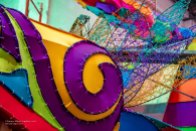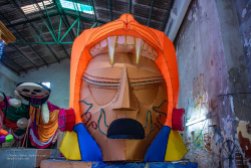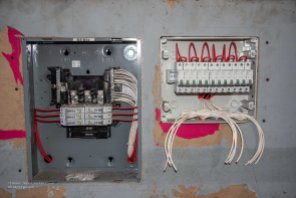Carnaval de Mazatlán 2019 is showing us some incredible artistry, and it’s allowed Greg and me to meet some outstanding artists! This week it was Jorge Osuna, creator of our magically illuminated floats these past nine years. Like me, you may be amazed how they seem to get better and better. Well, this very affable gentleman is an electrical engineer who also happens to have enjoyed drawing and music since he was a kid. He is constantly experimenting and playing around, trying things that haven’t been done before, so that he and his team can bring the most “wow” to Carnaval.
This year you’ll see the first monochromatic illuminated float (orange fabric) as well as the first black float (“people complain that black is not a happy Carnaval color, but at night, with the red lights, the black blends into the environment and it is just incredible!” Jorge tells us. Please remember that Cultura Mazatlán has asked the press not to publish photos of the floats prior to the parades. Thus, what you are seeing below are elements only. Click on any photo to enlarge it or view a slideshow.
Jorge did not study set-making, architecture or construction. He runs a lighting business, here and in Culiacán. He specializes in customizing lighting to the venue—the theme of the restaurant, business or event. Raúl Rico used to ask him to do lighting for special projects, staging, etc., and then in late 2009 he asked Jorge to make five floats for a night parade down the malecón. The parade was to accompany the second fireworks show that we did for a few years on Carnaval Monday and was designed to provide a family-friendly Carnaval option outside of drinking and revelry.
I remember that night well. None of us knew what to expect. All the lights on the malecón went dark. After the Child Queen’s coronation behind our house, we could see the five illuminated floats from a great distance, coming our way along the Avenida del Mar. Excitement built and people were thrilled. By the second year the event drew such a huge crowd that they were sadly forced to cancel it. Poof, just like that. Just like AeroFest, another fantastic event that is no longer. The purveyors in the “party zone” in Olas Altas had complained that the light-up parade and fireworks were robbing their crowd. The effort was killed by its own success.
This year the 20 or so workers in the Osuna Workshop will make their first-ever royal float, for the Child Queen, plus nine more—most of the children’s and Floral Games’ sections. In addition to their ten floats, the Osuna team will illuminate the Lewis Family floats. “Carnaval is the pride of Mazatlán. It’s for the pueblo, it’s of the pueblo. All of us who participate in putting it on are a team. We help and support each other. We each have unique contributions,” Jorge tells me.
This taller began working the second week of November. Most everything now is finished, electrified, and they are now “closing it all up,” which means wrapping it in fabric so that it glows and shines during the parades. I joked with Jorge that, as an electrical engineer, working on the Carnaval floats must have taught him a lot about fabric. He belly laughed and told me this story.
Jorge buys fabrics here in Mazatlán, but he also has to travel to Mexico City and Guadalajara to find the best fit for his purposes. People in the fabric shops don’t “get it;” they are used to selling fabric for dresses, curtains, blouses, not Carnaval floats. He remembers the first year, when he’d show up in a fabric shop. He had a light box with him, so he could stretch the fabric over it and see how it looked with the light behind it. It can’t be too translucent, or the bulbs show through; ideal is when it glows. The women in the fabric shop would chuckle and point, gossiping about the “crazy man over there.” Now, however, when he shows up at his favorite fabric shop in Guadalajara, they put Jorge at his own table, pull him up a chair and serve him refreshments. Now they understand the importance of his light box. They are proud to be a small part of Carnaval de Mazatlán, and they know he’ll leave their shop with loads and loads of fabric, helping them fulfill any sales quotas they might have. What a difference a few years makes!
“Mazatlecos have Carnaval in our genetic code. It is imprinted on us our entire lives. People from outside don’t get it,” Jorge told us. People from Guatemala, Veracruz, Mexico City, Chihuahua, Ensenada and Cozumel have asked IngenieroOsuna to make floats for their parades. “No,” he tells them, he is an electrical engineer, he has an empresato run. He does Carnaval de Mazatlán out of love for his city and the privilege to be part of his world-class hometown tradition.
Everything is artisanally done in this workshop. My book club buddy Henry Albuernes is a sculptor who forges the steel frames onto which the lights are fastened before their final draping in fabric. We witnessed a couple of talented women stretching fabric over these mountings and sewing them in place, and there were plenty of electricians working with fabric all over this workshop.
Yes, the electrical connections! You cannot believe how complicated this all is! A normal home, according to Jorge, uses about 4 kilowatts of electricity. Some of his floats use up to 30! He has actually had to install air conditioners inside floats to keep the lights from overheating!
We asked the Ingeniero what becomes of his floats after Carnaval. They are made of steel and will last a long time if stored safely. “I honestly don’t know,” he replies. “I would really like to see them be put to a good use. Given to a school or an orphanage or old folks’ home. The frames could be used to form cement for a permanent statue. I would love to see them come out again on Children’s Day, for a night time parade to delight the kids here in town.”
What are his hopes for Carnaval going forward? Like most of us in Mazatlán, he is also very much hoping that the rumored Carnaval museum becomes a reality. He also would very much like to see the parade route extended. He recommends starting at our new Sister Cities Park, which would add one kilometer to its distance, and also closing the beginning of Rafael Buelna, so that the floats can safely get to the Gran Plaza and the royalty and dancers can de-board securely and peacefully.
Interviewing the three Carnaval float talleres this year was a whole lot of fun. The first two articles can be found here, with Ocean Rodriguez, and here, with the Lewis Family. I hope we’ve helped you get excited about the parades. They are going to ROCK! We’ll see you there!























I went for a walk to see the decorations along the Malacon and have to say that I was very disappointed with the quality this year.
Yes, I have a long-standing tradition of photographing the monigotes every year. I can’t bring myself to do it this year. It’s insulting to the artists of MaxatlN, IMHO. The floats, however, are a delight. Enjoy the festivities!
Pingback: Cultures Grow on the Vine of Tradition | ¡VidaMaz!
Pingback: I’ve Seen Carnaval Future… | ¡VidaMaz!
Thank you for another interesting article, I love learning more about Mazatlan with you!
There is most definitely a lot to learn! Maybe that’s why MZT keeps us young! Thanks for being with me on the journey!